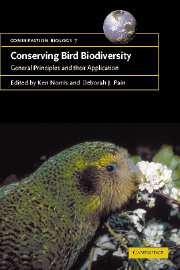Book contents
- Frontmatter
- Contents
- List of contributors
- Preface
- 1 Biodiversity – evolution, species, genes
- 2 Why conserve bird diversity?
- 3 Mapping and monitoring bird populations: their conservation uses
- 4 Priority-setting in species conservation
- 5 Selecting sites for conservation
- 6 Critically endangered bird populations and their management
- 7 Diagnosing causes of population declines and selecting remedial actions
- 8 Outside the reserve: pandemic threats to bird biodiversity
- 9 Predicting the impact of environmental change
- 10 Fragmentation, habitat loss and landscape management
- 11 The interface between research, education and training
- 12 Conservation policies and programmes affecting birds
- References
- Index
11 - The interface between research, education and training
Published online by Cambridge University Press: 10 December 2009
- Frontmatter
- Contents
- List of contributors
- Preface
- 1 Biodiversity – evolution, species, genes
- 2 Why conserve bird diversity?
- 3 Mapping and monitoring bird populations: their conservation uses
- 4 Priority-setting in species conservation
- 5 Selecting sites for conservation
- 6 Critically endangered bird populations and their management
- 7 Diagnosing causes of population declines and selecting remedial actions
- 8 Outside the reserve: pandemic threats to bird biodiversity
- 9 Predicting the impact of environmental change
- 10 Fragmentation, habitat loss and landscape management
- 11 The interface between research, education and training
- 12 Conservation policies and programmes affecting birds
- References
- Index
Summary
INTRODUCTION
There are many controversial issues in bird conservation. On some topics, however, a degree of unanimity can be expected. Most would agree that, especially in the tropics, our knowledge of many bird species and communities – their ecology and natural history, response to habitat change, even their population sizes – is extremely limited. For example, 79% of the world's 1,186 threatened bird species, mainly tropical, require baseline surveys to map their distributions, estimate population size or identify protected areas (BirdLife International 2000). It is often pointed out that this lack of knowledge, of birds or other biodiversity, should not be an excuse for a similar lack of action (WRI/IUCN/UNEP 1992; Gadgil 1996). Nevertheless, additional research would in many cases be helpful for designing more effective conservation approaches: at least we might have a better idea what we are talking about (Jenkins 1988; Stork & Samways 1995; Stuart 1995).
At the same time, the public's understanding of birds, and related issues to do with biodiversity conservation and sustainable resource use, is often desperately poor (WRI/IUCN/UNEP 1992; Miller et al. 1995; Orr 2000). Decision-makers are not immune, unfortunately, to this lack of awareness, and this in itself is a serious conservation problem. To carry out the research needed to underpin conservation, to educate the public and create awareness among those who make important decisions, and to enthuse and inspire younger scientists and conservation workers, we need well-trained personnel.
- Type
- Chapter
- Information
- Conserving Bird BiodiversityGeneral Principles and their Application, pp. 224 - 245Publisher: Cambridge University PressPrint publication year: 2002

